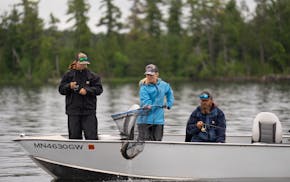Muskie fishing opens in Minnesota this weekend, but excitement for the season's first days isn't what it once was. That's because the state's lakes and rivers hold fewer muskies than they did a decade and more ago.
In fact, muskies — one of the world's most exciting sport fish — are at a crossroads in Minnesota. Perhaps in response, the Department of Natural Resources has announced development of a new muskie management plan, which likely won't be completed until next year. (I'll focus on the agency's perspective in an upcoming column.)
Whether the plan boosts muskie numbers in the approximately 100 Minnesota lakes and rivers that hold them (about half due to stocking) remains to be seen.
Below are snapshot interviews with three muskie-fishing experts — Bob Turgeon, 64, of the Twin Cities; Josh Stevenson, 48, a guide and owner of Blue Ribbon Bait in Oakdale; and muskie guide Josh Borovsky, 51, who fishes metro and northern lakes.
The status of Minnesota muskies
Stevenson: It's poor to below average and needs help. But the DNR appears to be doing very little to return muskies to their former populations. My understanding is that membership in Muskies Inc. is down as a result of declining interest. A guy who comes into my shop fishes aggressively and he caught only four muskies all last year in White Bear Lake.
Turgeon: The hours you put in vs. the reward is way down. A big issue is that stocking has not kept up with fishing pressure. Muskies took off when they were first stocked. But they've since settled back, in part I think due to too little stocking of larger muskies.
Borovsky: Muskies have taken a huge decline from where they were. Mille Lacs is the most obvious example of the DNR letting a fishery go downhill. Muskie stocking in Mille Lacs was stopped for four years in the early 2000s. Since then, they've stocked only 3,000 fish every other year. When Mille Lacs went downhill, its large army of muskie anglers dispersed, quadrupling pressure on many other lakes.
Is the DNR bowing to pressure from muskie opponents?
Turgeon: Whenever muskie stocking is proposed, opposition seems to spring up. Endless studies have determined what muskies eat, and it's not walleyes. But opponents keep saying the same thing, that muskies eat walleyes. In fact, some of the state's best walleye lakes are good muskie lakes.
Borovsky: Opposition to muskie stocking has been an issue in the past, in the Legislature particularly. In general, there's just been a lack of urgency at the DNR to address the problem. Mille Lacs, Minnetonka and Vermilion all took huge hits when they backed off stocking. Eventually, those declining fisheries caused all muskie fisheries to be overrun with pressure. Even with catch and release, there's delayed mortality.
Stevenson: Multiple studies have shown walleyes are not a primary prey fish of muskies. You would like to think the DNR would be guided by facts, not incorrect opinions. But the truth is that muskies have been down for quite a few years, and nothing significant at the DNR has happened in response.
Are muskie stocking adjustments needed?
Stevenson: Fingerling muskies have low survival when they're stocked, whereas larger muskies, meaning, generally, yearlings, have greater survival rates. The larger muskies cost more to produce. But if muskie anglers were informed about these expenses, I'm sure they would chip in more money than they already do to help. Unfortunately, the DNR distributes no reliable information about muskies' status, and what they plan to do about it, if anything.
Turgeon: Growing a muskie to 20 inches before stocking is obviously more expensive than stocking fingerlings. Those of us who are very involved in muskie fishing understand that. What we don't understand is why more of these fish aren't stocked. Is it cost? Politics? Whatever it is, let's acknowledge it and move forward.
Borovsky: If the DNR doesn't do something soon about stocking, I'll be too old to enjoy it. On Vermilion they did increase stocking in 2015, and we're starting to see some of those fish. But they're still sitting on their hands on Mille Lacs. Bringing it back would take a lot of pressure off other muskie lakes.
How have you adjusted to the downturn?
Stevenson: No guide can guarantee a muskie every trip. But in the past I produced enough to keep clients coming back. After all, catching a muskie is a life goal for many anglers. But the lower muskie populations have forced me more often to take clients bass or walleye fishing. Also, with my new jet boat, I explore new locations. If clients insist on muskies, I interview them extensively before taking the booking to make sure their stamina and expectations are in line with muskie numbers we're likely to encounter.
Turgeon: I still fish some metro lakes for muskies, but my expectations are way down. I've also been renting a Canadian lake cabin for a month in summer to find fishing similar to what I once had in Minnesota. In its prime, Mille Lacs was one of the best muskie lakes in the world. That's not even close to true now.
Borovsky: Higher fishing pressure for fewer fish has forced me and most other guides to adapt. Changing tactics and the lakes we fish and when we fish them are part of our adaptations. There's newfound pressure not only to refine our patterns but to be the first to create new patterns by designing new lures.

Anderson: In early June, Minnesota fish are begging to be caught. Won't you help?

Anderson: Tails wagging, DNR officers' dogs find lost people and missing evidence
Anderson: Punish poachers more
Anderson: The Chainsaw Sisters Saloon is gone, but the Echo Trail is still a pathway to possibilities





